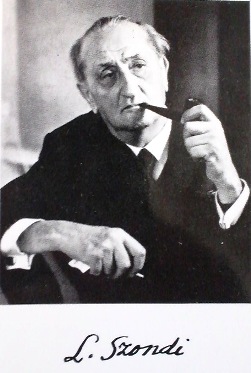心の迷宮を解く:ソンディの実践心理学の旅」

– レオポルド・ソンディは1893年にハンガリー領で生まれ、精神科医として活動した。
– 幼少時代の貧困と複雑な家庭環境が彼の家族の問題に対する過敏さを形成した。
– 医学部を卒業後、実験心理学研究所で助手として働き、記憶実験や知能測定を学んだ。
– ソンディは遺伝学への興味を持ち、精神病理学や精神療法に携わった。
– ナチの迫害により公職追放されるまで、精神病理学教室の講師および精神療法クリニックの医長を務めた。
– ソンディは衝動心理学を創始し、選択テストや衝動病理学を通じて思考精神医学の進化に貢献した。
– 彼の遺伝子記号に基づく「遺伝子の力動過程」を視覚化し、運命分析療法を創始した。
– ソンディは深層心理学を統一し、無意識の層として個人的無意識、集合的無意識、家族的無意識を指摘した。
– ソンディ・テストの結果により、精神分析的解釈、象徴分析的解釈、運命分析的解釈が同時に得られる構造を提唱した。
– 本書はソンディの遺産と方法を心理学徒やカウンセリング学習者に実用的な形で伝えている。
– Leopold Sondy was born in Hungary in 1893 and worked as a psychiatrist.
-His childhood poverty and complicated family environment shaped his sensitivity to family problems.
– After graduating from medical school, he worked as an assistant at the Institute of Experimental Psychology, where he learned memory experiments and intelligence measurement.
– Sondhi developed an interest in genetics and became involved in psychopathology and psychotherapy.
-He served as lecturer in the Department of Psychopathology and medical director of a psychotherapy clinic until he was forced out of his public office due to Nazi persecution.
– Sondhi founded drive psychology and contributed to the evolution of thought psychiatry through choice testing and drive pathology.
-He visualized the “dynamic process of genes” based on his genetic symbol and created fate analysis therapy.
– Sondhi unified deep psychology and pointed out the personal unconscious, collective unconscious, and family unconscious as the unconscious layers.
-Based on the results of the Sondhi test, he proposed a structure in which psychoanalytical, symbolic analytical, and fate analytical interpretations could be obtained simultaneously.
– This book conveys Sondhi’s legacy and methods in a practical way to psychologists and counseling students.

110306_2305
- レオポルド・ソンディは、1893年、当時のハンガリー領(現チェコスロハキヤ領)のニイトラという町で生まれる。父はユダヤ系ハンガリー人で、靴加工職人であった。彼は12人の同胞中、第12子で、かつ後妻の子であった。4歳の時、プタペストにいる異母兄にひきとられ成育した。その後1944年にナチのユダヤ追放の悲運に会うまでの47年間は、この地にあり、教育もこの地で受けたが、幼少時代からの貧困で複雑な家庭環境は、とりわけ異母兄夫婦のいさかいを見るにつけ、彼をして家族の問題に過敏にさせる素地を形成していった。
- 1911年に高校を卒業と同時に、医科進学のための国家試験に合格。1919年ブタペスト大学医学部より学位を取得している。
- 大戦後は、プタペスト大学のランシュブルグ教授が主宰する実験心理学研究所の助手にもなり、記憶実験や知能測定の実際を学んだ。最初の公刊論文は、この助手時代の成果である『欠陥知能』であった。
- 1927年、プタベストの治療教育大学の精神病理学教室の講師に任ぜられ、同時に精神療法クリニックの医長も兼務し、1941年、ナチの追害による公職追放にあうまで、この地位にあった。この14年間は、ハンガリー時代における精神科医としての、もっとも充実した活動の期間でもあった。ことに精神薄弱児の治療と教育に関連しての体質学への関心は、遺伝学への興味となり、ミュンヘン大学のルーディン一派の家系研究に傾倒した。やがて無意識の遺伝学として、配偶者選択や職業選択のあり方に注目させ、ソンディをして生涯のテーマである運命分析学の臨床家たらしめることになった。
1. ソンディはフロイトの精神分析の本質である「無意識の抑圧と防衛の力動過程」の構造を,思考や観念ではなく目に見える形で表現する選択テストを創案すると同時に,その理論として衝動の選択心理学を創始した.そして,その認識方法を,精神の治療面と診断面で実用化する衝動病理学,衝動診断学を展開し,それによって思考精神医学の退路を遮断,実用精神医学への道を開いた.選択は運命であるゆえ,それは運命分析へと発展したのである.
2. フロイトがいろいろな局面で言及し,立ち止まらざるを得なかった原因,つまり分析を困難ならしめる「素因的なもの」というのは,「いろいろな無意識層のうち特に祖先から伝わり現在その個人の精神に成り変わって自演している厄介な衝動の振る舞い」にほかならなかった.これはソンディ心理学において8個の遺伝子記号の様態で表現される.この「遺伝子の力動過程」を,構造的に視覚化する方法,およびその認識を治療面で実用する運命分析療法を創始し,「終わりなき分析」を終結させる方法を完成した.
要約すれば,ソンディは,フロィトが1905年以来,本能と明確に区別して追求した「衝動 1)」のふるまいを研究し,次のような衝動学の全体系を完成させたのである.
衝動心理学——–「衝動ファクタ・ペクタの心理学」および「実験的症候群論」
衝動測定学——–「ソンディ・テスト」器具,方法,一般的解釈法
衝動診断学——–「実験衝動診断学」および「リンネ式表」,特別な解釈法
衝動病理学——–「衝動病理学A,B」および「自我分析」
衝動分析学——–「運命分析」
衝動治療学——–「運命分析療法」
彼が,多くの流派に分裂した深層心理学を統一しようと考えていたことは,フロイトの真の後継者として当然であった.彼が深層心理学研究の主流と考えた無意識の層は,フロイトの個人的無意識,ユングの集合的無意識,そして彼自身の家族的無意識の3つの層である.
それゆえ,ソンディ・テストの結果得られる前景・理論背景・実験背景の3つの人格プロフィルは,それぞれの無意識層が表現される.すなわち
精神分析的解釈(S.Freud)
象徴分析的解釈(C.G.Jung)
運命分析的解釈(L.Szondi)
の3通りの解釈が同時に実現し,了解され,説明される構造になっている.
本書は,ソンディがフロイトの遺言を完全に引き受け,延長し,無意識の遺伝学と診断・治療学を完成した事実と方法を,心理学徒やカウンセリングを学ぶ人にとって,すぐ役に立つ実用的な形で記載したものである.原稿を書くにあたって先人の訳業も充分に活用したが,重要部分は必ず原著に当たるとともに,ソンディに会って直接確かめた事項に基づき,新たな解釈を付け加えた部分も多い.
本書の各項にちりばめられているソンディの学説は,以下にあげる主要原著から得られたものである.
「運命分析」(1944,1948,1964)
「ソンディテスト」(1946)
「衝動病理学A,B」(1951)
「自我分析」(1956)
「衝動リンネ式表」(1960)
「実験衝動診断法」(1960)
「運命分析療法」(1963)
「衝動統合を失った人々」(1979)
Leopold Sondi was born in 1893 in the town of Nyitra in what was then Hungary (now Czechoslovakia). His father was a Hungarian Jew and a shoemaker. He was the twelfth child of twelve brethren, and the son of his second wife. When he was four years old, he was taken in by his half-brother in Ptapest to grow up. After that, he lived here for 47 years until he met the fate of the Nazis’ expulsion of the Jews in 1944, and was educated there, but his family was poor and had a complicated family environment from an early age, especially when there were conflicts between his half-brother and his wife. The more I watched him, the more I developed a tendency to make him sensitive to family problems.
Upon graduating from high school in 1911, he passed the national exam to enter medicine. He received his degree from Budapest University Faculty of Medicine in 1919.
After the war, he also became an assistant at the Institute of Experimental Psychology headed by Professor Ranschburg at the University of Putapest, where he learned the practicalities of memory experiments and intelligence measurement. His first published paper was “Defective Intelligence,” which was the result of his time as an assistant.
In 1927, he was appointed lecturer in the Department of Psychopathology at the University of Therapeutic Education in Ptavest, and at the same time served as medical director of the psychotherapeutic clinic, a position he held until 1941, when he was expelled from public office due to Nazi persecution. . These 14 years were also the most fulfilling period of his career as a psychiatrist during his Hungarian years. His interest in constitutional science, especially in relation to the treatment and education of mentally retarded children, led to his interest in genetics and to the genealogical studies of the Rudin family at the University of Munich. Eventually, he drew attention to the way we choose our spouse and career as a result of unconscious genetics, and made Sondhi a clinician in fate analysis, which was the theme of his life.
1. Sondhi created a multiple-choice test that expressed the structure of the “dynamic process of unconscious repression and defense,” which is the essence of Freud’s psychoanalysis, in a visible form rather than through thoughts or ideas. Founded choice psychology. He developed impulse pathology and impulse diagnosis to put his cognitive methods into practical use in the therapeutic and diagnostic aspects of the psyche, thereby blocking the retreat of thinking psychiatry and paving the way for practical psychiatry. . Since choice is fate, it evolved into fate analysis.
2. The “predispositional factors,” which Freud mentioned in various situations and which he had no choice but to stop at, that make analysis difficult, are “particularly the various unconscious layers that have been passed down from ancestors and are currently present in the individual.” It was nothing but the behavior of troublesome impulses acting out themselves in the guise of a spirit. This is expressed in the form of eight genetic symbols in Sondhi psychology. He created a method to structurally visualize this “genetic dynamic process,” and a fate analysis therapy that puts this recognition into practical use in treatment, and completed a method to end “endless analysis.”
In summary, Sondhi studied the behavior of “drives 1),” which Freud had pursued since 1905, clearly distinguishing them from instincts, and completed the following overall system of drive theory.
Impulse Psychology ——– “Psychology of Impulse Factors and Pectas” and “Experimental Syndrome Theory”
Impulse measurement———“Sondhi test” instruments, methods, and general interpretation methods
Impulse diagnosis ——– “Experimental impulse diagnosis” and “Linnaean table”, special interpretation method
Impulse pathology ——– “Impulsive pathology A, B” and “Ego analysis”
Impulse analysis ——– “Fate analysis”
Impulse therapy ——– “Fate analysis therapy”
As Freud’s true successor, it was only natural that he wanted to unify depth psychology, which was divided into many schools. The three layers of the unconscious that he considered to be the mainstream of deep psychological research were Freud’s personal unconscious, Jung’s collective unconscious, and his own familial unconscious.
Therefore, the three personality profiles obtained as a result of the Sondhi test – foreground, theoretical background, and experimental background – express each unconscious layer. i.e.
Psychoanalytic interpretation (S.Freud)
Symbolic analysis interpretation (C.G.Jung)
Fate analytical interpretation (L.Szondi)
The structure is such that three interpretations can be realized, understood, and explained at the same time.
This book describes the facts and methods by which Sondhi fully accepted and extended Freud’s will and perfected the genetics of the unconscious and diagnosis and treatment in a practical format that is immediately useful for psychologists and those studying counseling. This is what I did. In writing the manuscript, I made full use of the translation work of my predecessors, but while important parts are always based on the original work, there are also many parts where I have added new interpretations based on what I have personally confirmed by meeting Sondhi.
Sondhi’s theories, which are scattered throughout each section of this book, are derived from the main original works listed below.
“Fate Analysis” (1944,1948,1964)
“Sondi Test” (1946)
“Impulsive Pathology A, B” (1951)
“Ego Analysis” (1956)
“Impulsive Linnaean Table” (1960)
“Experimental Impulse Diagnosis” (1960)
“Fate analysis therapy” (1963)
“People who have lost impulse integration” (1




